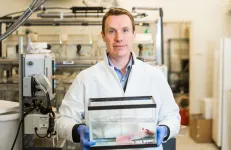(Press-News.org) URBANA, Ill. -When pigs get hit with significant illnesses during key stages of pregnancy, their immune response may negatively affect developing piglets, making them less productive on the farm. New research from the University of Illinois shows that when those piglets - especially males - experience a second stressor in early life, they are at higher risk of neurodevelopmental and other neurological anomalies, putting them at an even greater disadvantage in production settings.
"With more information about maternal illness, what we call maternal immune activation, we can make better decisions about how to handle these types of immune challenges within animal production settings," says Marissa Keever-Keigher, doctoral student in the Department of Animal Sciences at Illinois and lead researcher on the study.
Studying brain development in the domestic pig is relevant on the farm, of course, but pig studies can also inform human neurodevelopmental research. That's because the pig's development, genetics, brain structure, and more are very similar to our own.
In previous pig studies looking at the effects of maternal immune activation, Keever-Keigher and her colleagues showed important genetic changes occur in the piglet amygdala, a brain structure that plays an important role in learning, social behavior, and stress response in both humans and pigs.
The researchers also knew from primate and rodent studies that a second immune challenge, known as a double hit, can further disrupt typical brain development in young animals. To test the double hit hypothesis in pigs, the team chose weaning as the second challenge.
"While weaning is not itself an immune challenge, it is an extremely stressful time during a piglet's life and can elicit an immune response," says Haley Rymut, doctoral student in animal sciences and co-author on the study. "Piglets have to deal with a broad array of stressors, including physical stressors from being handled and moved, and emotional stressors from being taken away from the mom and placed with their peers. Any of those physical or emotional stressors can kick off an immune response."
The researchers looked at a combination of factors for piglets in the study: whether or not their moms were infected with porcine reproductive and respiratory syndrome virus (PRRSV) during gestation, and whether or not they were weaned at 21 days of age, the typical age in production settings. They also noted the sex of the piglets, as their earlier research indicated male piglets showed more changes in the amygdala as a result of maternal illness.
"Using high throughput sequencing technologies, we were able to monitor the levels of more than 16,000 genes in the pigs. We uncovered more than 100 genes and molecular pathways affected by either maternal immune activation, weaning, sex, or a combination of factors in the amygdala on day 22 for all piglets. The effect of pre- and postnatal stressors on neuropeptide genes confirms the plasticity of the infant brain during development to respond and adapt to challenges," says Sandra Rodriguez-Zas, professor in animal sciences and faculty advisor to Keever-Keigher and Rymut. Rodriguez-Zas is principal investigator of the U.S. Department of Agriculture-funded study.
Many of the genes expressed at higher or lower-than-typical rates in weaned piglets from virus-infected mothers have been associated with autism spectrum disorder (ASD) and schizophrenia spectrum disorder (SSD) in previous studies. But genes relevant to other neurological disorders were affected too.
"We also found changes in expression of genes associated with neurodegenerative diseases like Huntington's and Alzheimer's disease," Keever-Keigher says.
As in the scientists' previous work, the double hit affected male piglets more than females, with greater dysregulation of genes in the amygdala. The researchers found evidence of more protective pathways in female brains, giving them an advantage in handling stressful events.
The study provides valuable clues for researchers studying ASD, SSD, and neurodegenerative disorders in humans, even though some aspects might not translate directly.
Rymut says, "For most children, weaning isn't nearly as stressful as it is for pigs in a production setting. But many other traumatic events early in childhood could set up that double hit."
On the farm, pigs from virus-infected mothers often show anti-social behaviors. Because pigs are typically group-housed and fed via communal feeders, pigs that don't like being around their peers are often last to feed and generally more stressed, leading to slower growth rates and lower overall body condition scores.
"The lesson for swine producers, I think, is to be really mindful of stressful conditions in the production cycle, and try to mitigate those as much as we can in order to create the most productive and healthy livestock animals and benefit producers' bottom lines," Keever-Keigher says.
Rymut adds, "Also, knowing how the different sexes respond could help producers manage animals that are less likely to be productive as a result of maternal immune activation."
INFORMATION:
The article, "Interacting impact of maternal inflammatory response and stress on the amygdala transcriptome of pigs," is published in G3 Genes|Genomes|Genetics [DOI: 10.1093/g3journal/jkab113]. The research was supported by the National Institutes of Health and the U.S. Department of Agriculture's "Dual Purpose for Dual Benefit" program (grant number 2018-67015-27413). Rod Johnson, professor and head of the Department of Animal Sciences is co-investigator on the grant and co-author on the G3 paper.
The Department of Animal Sciences is in the College of Agricultural, Consumer and Environmental Sciences at the University of Illinois.
In a new study, University of Maine researchers found that culture helps humans adapt to their environment and overcome challenges better and faster than genetics.
After conducting an extensive review of the literature and evidence of long-term human evolution, scientists Tim Waring and Zach Wood concluded that humans are experiencing a "special evolutionary transition" in which the importance of culture, such as learned knowledge, practices and skills, is surpassing the value of genes as the primary driver of human evolution.
Culture is an under-appreciated factor in human evolution, Waring ...
Icebergs crumbling into the sea may be what first come to mind when imagining the most dramatic effects of global warming.
But new University of Arizona-led research, published in Geophysical Research Letters, suggests that more record-breaking temperatures will actually occur in the tropics, where there is a large and rapidly growing population.
"People recognize that polar warming is much faster than the mid-latitudes and tropics; that's a fact," said lead study author Xubin Zeng, director of the UArizona Climate Dynamics and Hydrometeorology Center and a professor of atmospheric sciences. "The second fact is that the warming over land is greater than over ...
People of color are more than twice as likely to die after a traumatic brain injury as white people, according to a new retrospective review from Oregon Health & Science University.
The study published today in the journal Frontiers in Surgery.
In the report, "Racial and Ethnic Inequities in Mortality During Hospitalization for Traumatic Brain Injury: A Call to Action," the researchers analyzed more than a decade of data related to the health outcomes and demographics of thousands of patients treated for traumatic head injuries at OHSU Hospital, one of two Level 1 trauma centers in the state.
They found a clear delineation of worse outcomes for people of color.
"We have a societal and professional duty to recognize and accept that the effects of structural ...
Hydrogels are commonly used inside the body to help in tissue regeneration and drug delivery. However, once inside, they can be challenging to control for optimal use. A team of researchers in the Department of Biomedical Engineering at Texas A&M University is developing a new way to manipulate the gel -- by using light.
Graduate student Patrick Lee and Dr. Akhilesh Gaharwar, associate professor, are developing a new class of hydrogels that can leverage light in a multitude of ways. Light is a particularly attractive source of energy as it can be confined to a predefined area as well as be finetuned by the time or intensity of light exposure. Their work was recently published in the journal Advanced Materials.
Light?responsive hydrogels are an ...
OAKLAND, Calif. -- In patients with insulin-treated type 2 diabetes, the use of continuous glucose monitors is associated with better blood sugar control and fewer visits to the emergency room for hypoglycemia, a Kaiser Permanente study published June 2 in the journal JAMA found.
The monitors have previously been shown to improve glucose control for patients with type 1 diabetes. Continuous glucose monitors are now the standard of care for these patients.
"The improvement in blood sugar control was comparable to what a patient might experience after starting a new diabetes medication," said the study's lead author Andrew J. Karter, PhD, a senior research scientist with the Kaiser Permanente Northern California ...
What The Study Did: Researchers investigated the effect of real-time continuous glucose monitoring on glycemic control among patients with insulin-treated diabetes.
Authors: Andrew J. Karter, Ph.D., of Kaiser Permanente in Oakland, California, is the corresponding author.
To access the embargoed study: Visit our For The Media website at this link https://media.jamanetwork.com/
(doi:10.1001/jama.2021.6530)
Editor's Note: The article includes conflict of interest and funding/support disclosures. Please see the article for additional information, including other authors, author contributions and affiliations, conflict of interest and financial disclosures, and funding and support.
INFORMATION:
Media advisory: The full study and editorial ...
BAR HARBOR, MAINE — Many salamanders can readily regenerate a lost limb, but adult mammals, including humans, cannot. Why this is the case is a scientific mystery that has fascinated observers of the natural world for thousands of years.
Now, a team of scientists led by James Godwin, Ph.D., of the MDI Biological Laboratory in Bar Harbor, Maine, has come a step closer to unraveling that mystery with the discovery of differences in molecular signaling that promote regeneration in the axolotl, a highly regenerative salamander, while blocking it in the adult mouse, which is a mammal with limited regenerative ability.
"Scientists at ...
Researchers from Carnegie Mellon University's Computational Biology Department in the School of Computer Science have developed a new process that could reinvigorate the search for natural product drugs to treat cancers, viral infections and other ailments.
The machine learning algorithms developed by the Metabolomics and Metagenomics Lab match the signals of a microbe's metabolites with its genomic signals and identify which likely correspond to a natural product. Knowing that, researchers are better equipped to isolate the natural product to begin developing it for a possible drug.
"Natural products are still one of the most successful paths for drug discovery," said Bahar Behsaz, a project scientist in the lab and lead author of a paper about the process. "And ...
A team of Colorado State University scientists, led by veterinary postdoctoral fellow Dr. Anna Fagre, has detected Zika virus RNA in free-ranging African bats. RNA, or ribonucleic acid, is a molecule that plays a central role in the function of genes.
According to Fagre, the new research is a first-ever in science. It also marks the first time scientists have published a study on the detection of Zika virus RNA in any free-ranging bat.
The findings have ecological implications and raise questions about how bats are exposed to Zika virus in nature. The study was recently published in Scientific Reports, a journal published by Nature Research.
Fagre, a researcher at CSU's Center for Vector-Borne Infectious Diseases, ...
ITHACA, N.Y. - All fish are not created equal, at least when it comes to nutritional benefits.
This truth has important implications for how declining fish biodiversity can affect human nutrition, according to a computer modeling study led by Cornell and Columbia University researchers.
The study, "Declining Diversity of Wild-Caught Species Puts Dietary Nutrient Supplies at Risk," published May 28 in Science Advances, focused on the Loreto region of the Peruvian Amazon, where inland fisheries provide a critical source of nutrition for the 800,000 inhabitants.
At the same time, the findings apply to fish biodiversity worldwide, as more than 2 billion people depend on fish as their primary source of animal-derived nutrients.
"Investing in safeguarding biodiversity can deliver ...



